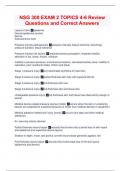NSG 300 EXAM 2 TOPICS 4-6 Review
Questions and Correct Answers
Layers of skin ✅epidermis
Dermal-epidermal junction
Dermis
Subcutaneous layer
Pressure injuries pathogenesis ✅pressure intensity (tissue ischemia, blanching),
pressure duration, tissue tolerance
Pressure injuries risk factors ✅impaired sensory perception, impaired mobility,
alteration in loc, shear, friction, moisture
Inability to perceive pressure, incontinence/moisture, decreased activity level, inability to
reposition, poor nutritional intake, friction and shear
Stage 1 pressure injury ✅non-blanchable erythema of intact skin
Stage 2 pressure injury ✅partial-thickness skin loss with exposed dermis
Stage 3 pressure injury ✅full-thickness skin loss
Stage 4 pressure injury ✅full-thickness skin and tissue loss
Unstageable pressure injury ✅full-thickness skin and tissue loss obscured by slough or
eschar
Medical device-related pressure injuries (mdrpi) ✅occurs when the skin or underlying
tissues are subjected to sustained pressure or shear from medical devices or equipment
Medical adhesive-related skin injury (marsi) ✅occurs from tape and other medical
adhesives
Ex: securing ostomy devices
Partial-thickness wound repair ✅wounds that involve only a partial loss of skin layers
(the epidermis and superficial dermal layers)
Shallow in depth, moist, and painful, and the wound base generally appears red
Full-thickness wound repair ✅wounds that involve total loss of the skin layers
(epidermis and dermis)
,Extends into the subcutaneous layer and can be painful, and the depth and tissue type
vary depending on body location
Primary intention healing ✅wound that is closed
Ex: hematoma, surgical incision that is sutured or stapled
Healing occurs by epithelialization; heals quickly with minimal scar formation
Secondary intention healing ✅wound edges not closed or approximated
Ex: surgical wounds that have tissue loss or contamination
Wound heals by granulation tissue formation, wound contraction, and epithelialization.
Tertiary intention healing ✅wound that is left open for several days; then wound edges
are approximated
Ex: wounds that are contaminated and require observation for signs of inflammation
Closure of wound is delayed until risk of infection is resolved
Complications of wound healing ✅hemorrhage, infection, dehiscence, evisceration
Prediction and prevention of pressure injuries ✅risk assessment, economic
consequences of pressure injuries
Braden risk assessment scale ✅pressure injury risk assessment
6 subscales: sensory perception, moisture, activity, mobility, nutrition, friction/shear
Factors influencing pressure injury formation and wound healing ✅nutrition, tissue
perfusion, infection, age, psychosocial impact of wounds
Implementation for risk of pressure injuries ✅nutrition, topical skin care and
incontinence management, positioning, support surfaces
Implementing acute wound care ✅comfort measures, cleaning skin and drain sites,
basic skin cleaning, irrigation, skin closures, drainage evacuation, bandages, binders,
slings, heat and cold therapy
Abrasion ✅superficial with little bleeding and is considered a partial-thickness wound
Often appears "weepy" because of plasma leakage from damaged capillaries
, Approximated ✅closed wound edges
Risk of infection is low
Blanchable hyperemia ✅erythema that blanches
Transient and is an attempt to overcome the ischemic episode
Blanching ✅when the normal red tones of the light-skinned patient are absent
Debridement ✅the removal of nonviable, necrotic tissue
Necessary to rid the wound of a source of infection, enable visualization of the wound
bed, and provide a clean base necessary for healing
Dehiscence ✅partial or total separation of wound layers
Epithelialization ✅wound resurfacing
Part of proliferation
Eschar ✅black, brown, tan, or necrotic tissue
Evisceration ✅protrusion of visceral organs through a wound opening
Exudate ✅fluid from wound
Excessive = infection
Fluctuance ✅soft, boggy feeling when tissue is palpated; usually a sign of tissue
infection
Friction ✅effects of rubbing or the resistance that a moving body meets from the
surface on which it moves; a force that occurs in a direction to oppose movement
Granulation tissue ✅red, moist tissue composed of new blood vessels
Indicated progression toward healing
Hemostasis ✅involves a series of physiological events designed to control blood loss,
establish bacterial control, and seal the defect that occurs when there is an injury
Injured blood vessels constrict and platelets gather to stop bleeding




